Book contents
- Frontmatter
- Contents
- Preface
- INTRODUCTION
- I RATIONALITY AND MORALITY
- II WELFARE AND CONSEQUENCES
- III LIBERTY, RIGHTS, EQUALITY, AND JUSTICE
- 10 Liberty, Rights, and Libertarianism
- 11 Equality and Egalitarianism
- 12 Justice and Contractualism
- IV MORAL MATHEMATICS
- CONCLUSIONS
- Appendix: How Could Ethics Matter to Economics?
- Glossary
- References
- Index
11 - Equality and Egalitarianism
Published online by Cambridge University Press: 06 July 2010
- Frontmatter
- Contents
- Preface
- INTRODUCTION
- I RATIONALITY AND MORALITY
- II WELFARE AND CONSEQUENCES
- III LIBERTY, RIGHTS, EQUALITY, AND JUSTICE
- 10 Liberty, Rights, and Libertarianism
- 11 Equality and Egalitarianism
- 12 Justice and Contractualism
- IV MORAL MATHEMATICS
- CONCLUSIONS
- Appendix: How Could Ethics Matter to Economics?
- Glossary
- References
- Index
Summary
The contemporary world is full of inequalities that most people find profoundly disturbing. For example, the median wealth of American families of African ancestry is about one tenth that of families of European ancestry. In 2000, life expectancy at birth in Japan was about 81, compared to 38 in Angola. In 1970, the top hundred American executives earned on average 38 times what the average full-time worker earned; in 2000, the ratio was more than 1,000 to 1 (Detroit News, 19 December 2002). One percent of Americans own at least a third of all America's wealth, while the bottom 40% of the population has only 1%. In 1998, the assets of the world's 358 billionaires were greater than the combined incomes of countries with 45% of the world's population – more than 2.5 billion people (〈http://www.globalpolicy.org/socecon/inequal/〉). Inequalities in wealth also correlate with other inequalities. Unsurprisingly, those who are richer tend to have higher incomes. Those with higher incomes also tend to be healthier, better educated, of higher status, taller, and to have more political influence.
What's wrong with inequalities? Why do most people find these inequalities so troubling? Notice first that it is not just the size of the inequalities that makes them disturbing. The disparity of life expectancy between infants born with Tay-Sachs disease (who usually die before age 5) and those without the disease dwarfs the inequalities in life expectancy between Japan and Angola, but it does not raise the same moral problems. Why?
- Type
- Chapter
- Information
- Economic Analysis, Moral Philosophy and Public Policy , pp. 174 - 197Publisher: Cambridge University PressPrint publication year: 2006



